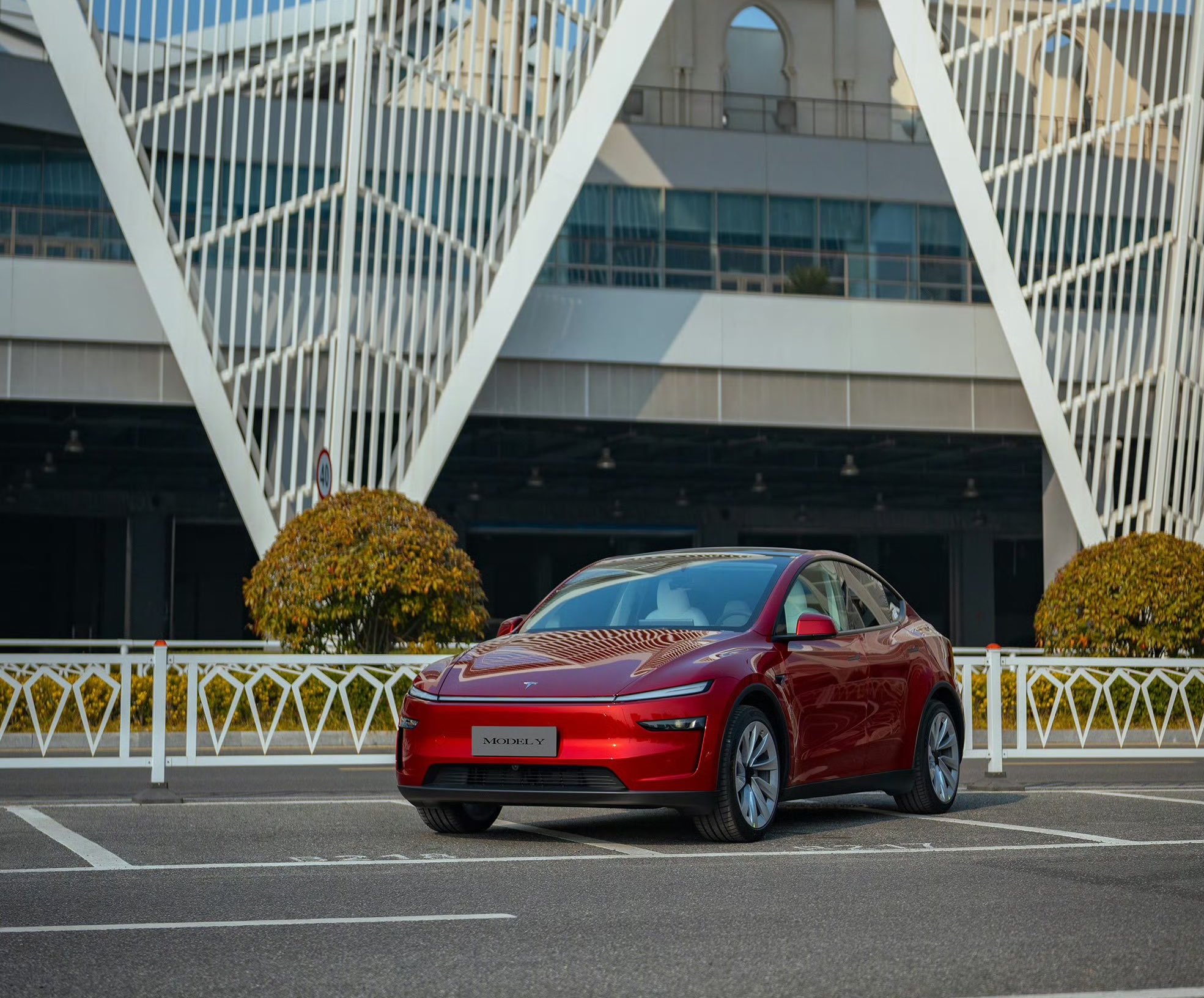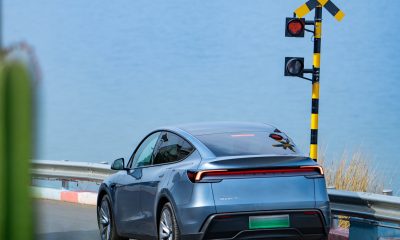

News
Tesla patent hints at possible Model S, X refresh with new HVAC system
Details coming out of a new international patent application filed by Tesla reveals an infotainment-controlled HVAC system that could be intended for an upcoming Model S and Model X refresh.
A similar HVAC control system has already been rolled out by Tesla in its compact electric sedan, the Model 3. The Model 3 uses two intersecting planes of air for vertical control. Lateral fins hidden within the electric car’s dashboard provide horizontal air control while also providing a clean, minimalistic look. Tesla’s filed patent describes features that are similar to Model 3’s air vent system that’s controlled through its 15″ center touchscreen. Patent US2017 / 058015 titled “Infotainment System with Air-Vent Control,” describes a system to manipulate the airflow inside the vehicle through the vehicle’s media control unit.
The air vent assembly includes a first vent portion placed in front of the driver and a second vent portion that is placed in front of the passenger. These vent portions may be elongated as compared to traditionally known designs of air vent assemblies in that they have longer, more linear vents instead of more circular or boxy vents.
Embodiments of the present disclosure enhance the capabilities of this air vent assembly to provide air flow in a leftward, rightward, onward, and a split configuration using a single rotary actuator. In certain embodiments, the user interface may also allow a user to define the degree to which the vents may cause air to flow in the rightward, leftward, or split direction.
Similar to Model 3’s unique HVAC system, the one described in the patent application also allows passengers to customize the airflow within the vehicle according to passenger preferences.
In certain embodiments, the user customizes the airflow, for example, the specific direction of the airflow. This can allow for a more comfortable experience for the occupants of a vehicle. For example, certain occupants may desire for air to be directed towards themselves while other occupants may desire the temperature of the vehicle cabin to be set to a certain value without having air directly impinging on themselves.
An illustration of Tesla’s recent patent on an infotainment-controlled HVAC system. [Credit: World Intellectual Property Organization]
With anticipation running high that Model S and Model X is due for a refresh, an update to its HVAC system would not only unify the dashboard design across its fleet of vehicles but could also simplify production. For one, Tesla’s unique air vent system requires less hardware and thus minimizes the need for multiple suppliers. Using a simpler design, Tesla’s thinner HVAC system can efficiently utilize space in the dashboard, and provide a much more expansive interior feel. Such a system, as proven by the Model 3, would also give drivers better road visibility.
While Tesla’s international patent application did not specifically mention a vehicle model, illustrations included in the document resembles the design of the Model S and Model X’s dashboard. Figure 1, for example, features a dashboard that is similar to the all-electric luxury sedan and SUV. Apart from a similar-looking instrument cluster and infotainment system, the illustration also features a dashboard curvature that’s aligned with that of Model S and Model X’s current design. Armrest cupholders located between the front seats at the bottom of Fig. 1 also draws resemblance to ones found in the Model S and Model X.
Adopting an HVAC system that’s akin to the Model 3 for the Model S and Model X would likely be a welcomed change for Tesla enthusiasts. During his testing and teardown of the vehicle earlier this year alone, Detroit veteran Sandy Munro, who issued a harsh critique of the electric car’s build quality, admitted in a later comment that the Model 3’s HVAC system was “brilliant,” citing its simple yet ingenious design.
Aside from major refreshes, Tesla continues to improve the components of its vehicles over time. As revealed by Elon Musk in a recent conversation with Consumer Reports’ Jake Fisher, the Tesla CEO noted that improvements have been rolled out to the Model 3 since its production began, from better interior materials that reduce road noise to a software update that improves the vehicles’ controls. Tesla’s flagship Model S and Model X are no strangers to this, and a revamped HVAC system can only improve the experience for its driver and passengers.
Elon Musk
Tesla analysts believe Musk and Trump feud will pass
Tesla CEO Elon Musk and U.S. President Donald Trump’s feud shall pass, several bulls say.

Tesla analysts are breaking down the current feud between CEO Elon Musk and U.S. President Donald Trump, as the two continue to disagree on the “Big Beautiful Bill” and its impact on the country’s national debt.
Musk, who headed the Department of Government Efficiency (DOGE) under the Trump Administration, left his post in May. Soon thereafter, he and President Trump entered a very public and verbal disagreement, where things turned sour. They reconciled to an extent, and things seemed to be in the past.
However, the second disagreement between the two started on Monday, as Musk continued to push back on the “Big Beautiful Bill” that the Trump administration is attempting to sign into law. It would, by Musk’s estimation, increase spending and reverse the work DOGE did to trim the deficit.
Every member of Congress who campaigned on reducing government spending and then immediately voted for the biggest debt increase in history should hang their head in shame!
And they will lose their primary next year if it is the last thing I do on this Earth.
— Elon Musk (@elonmusk) June 30, 2025
President Trump has hinted that DOGE could be “the monster” that “eats Elon,” threatening to end the subsidies that SpaceX and Tesla receive. Musk has not been opposed to ending government subsidies for companies, including his own, as long as they are all abolished.
How Tesla could benefit from the ‘Big Beautiful Bill’ that axes EV subsidies
Despite this contentious back-and-forth between the two, analysts are sharing their opinions now, and a few of the more bullish Tesla observers are convinced that this feud will pass, Trump and Musk will resolve their differences as they have before, and things will return to normal.
ARK Invest’s Cathie Wood said this morning that the feud between Musk and Trump is another example of “this too shall pass:”
BREAKING: CATHIE WOOD SAYS — ELON AND TRUMP FEUD “WILL PASS” 👀 $TSLA
She remains bullish ! pic.twitter.com/w5rW2gfCkx
— TheSonOfWalkley (@TheSonOfWalkley) July 1, 2025
Additionally, Wedbush’s Dan Ives, in a note to investors this morning, said that the situation “will settle:”
“We believe this situation will settle and at the end of the day Musk needs Trump and Trump needs Musk given the AI Arms Race going on between the US and China. The jabs between Musk and Trump will continue as the Budget rolls through Congress but Tesla investors want Musk to focus on driving Tesla and stop this political angle…which has turned into a life of its own in a roller coaster ride since the November elections.”
Tesla shares are down about 5 percent at 3:10 p.m. on the East Coast.
Elon Musk
Tesla scrambles after Musk sidekick exit, CEO takes over sales
Tesla CEO Elon Musk is reportedly overseeing sales in North America and Europe, Bloomberg reports.

Tesla scrambled its executives around following the exit of CEO Elon Musk’s sidekick last week, Omead Afshar. Afshar was relieved of his duties as Head of Sales for both North America and Europe.
Bloomberg is reporting that Musk is now overseeing both regions for sales, according to sources familiar with the matter. Afshar left the company last week, likely due to slow sales in both markets, ending a seven-year term with the electric automaker.
Tesla’s Omead Afshar, known as Elon Musk’s right-hand man, leaves company: reports
Afshar was promoted to the role late last year as Musk was becoming more involved in the road to the White House with President Donald Trump.
Afshar, whose LinkedIn account stated he was working within the “Office of the CEO,” was known as Musk’s right-hand man for years.
Additionally, Tom Zhu, currently the Senior Vice President of Automotive at Tesla, will oversee sales in Asia, according to the report.
It is a scramble by Tesla to get the company’s proven executives over the pain points the automaker has found halfway through the year. Sales are looking to be close to the 1.8 million vehicles the company delivered in both of the past two years.
Tesla is pivoting to pay more attention to the struggling automotive sales that it has felt over the past six months. Although it is still performing well and is the best-selling EV maker by a long way, it is struggling to find growth despite redesigning its vehicles and launching new tech and improvements within them.
The company is also looking to focus more on its deployment of autonomous tech, especially as it recently launched its Robotaxi platform in Austin just over a week ago.
However, while this is the long-term catalyst for Tesla, sales still need some work, and it appears the company’s strategy is to put its biggest guns on its biggest problems.
News
Tesla upgrades Model 3 and Model Y in China, hikes price for long-range sedan
Tesla’s long-range Model 3 now comes with a higher CLTC-rated range of 753 km (468 miles).

Tesla has rolled out a series of quiet upgrades to its Model 3 and Model Y in China, enhancing range and performance for long-range variants. The updates come with a price hike for the Model 3 Long Range All-Wheel Drive, which now costs RMB 285,500 (about $39,300), up RMB 10,000 ($1,400) from the previous price.
Model 3 gets acceleration boost, extended range
Tesla’s long-range Model 3 now comes with a higher CLTC-rated range of 753 km (468 miles), up from 713 km (443 miles), and a faster 0–100 km/h acceleration time of 3.8 seconds, down from 4.4 seconds. These changes suggest that Tesla has bundled the previously optional Acceleration Boost for the Model 3, once priced at RMB 14,100 ($1,968), as a standard feature.
Delivery wait times for the long-range Model 3 have also been shortened, from 3–5 weeks to just 1–3 weeks, as per CNEV Post. No changes were made to the entry-level RWD or Performance versions, which retain their RMB 235,500 and RMB 339,500 price points, respectively. Wait times for those trims also remain at 1–3 weeks and 8–10 weeks.
Model Y range increases, pricing holds steady
The Model Y Long Range has also seen its CLTC-rated range increase from 719 km (447 miles) to 750 km (466 miles), though its price remains unchanged at RMB 313,500 ($43,759). The model maintains a 0–100 km/h time of 4.3 seconds.
Tesla also updated delivery times for the Model Y lineup. The Long Range variant now shows a wait time of 1–3 weeks, an improvement from the previous 3–5 weeks. The entry-level RWD version maintained its starting price of RMB 263,500, though its delivery window is now shorter at 2–4 weeks.
Tesla continues to offer several purchase incentives in China, including an RMB 8,000 discount for select paint options, an RMB 8,000 insurance subsidy, and five years of interest-free financing for eligible variants.
-

 Elon Musk1 day ago
Elon Musk1 day agoTesla investors will be shocked by Jim Cramer’s latest assessment
-

 News6 days ago
News6 days agoTesla Robotaxi’s biggest challenge seems to be this one thing
-

 News2 weeks ago
News2 weeks agoTesla’s Grok integration will be more realistic with this cool feature
-

 Elon Musk2 weeks ago
Elon Musk2 weeks agoElon Musk slams Bloomberg’s shocking xAI cash burn claims
-

 News2 weeks ago
News2 weeks agoTesla China roars back with highest vehicle registrations this Q2 so far
-

 News2 weeks ago
News2 weeks agoTexas lawmakers urge Tesla to delay Austin robotaxi launch to September
-

 News2 weeks ago
News2 weeks agoTesla dominates Cars.com’s Made in America Index with clean sweep
-

 Elon Musk1 week ago
Elon Musk1 week agoFirst Look at Tesla’s Robotaxi App: features, design, and more


















